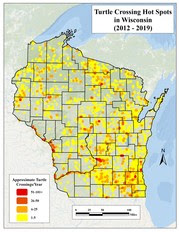MADISON, Wis. – With a 45% increase in turtle crossing reports in the last year and a growing number of landowners taking action to protect turtle nests from raccoons, state conservation biologists are hopeful for the next generation of these hard-shelled reptiles.
The Wisconsin Department of Natural Resources’ biologists are asking the public to continue reporting turtle crossings online for the DNR’s Wisconsin Turtle Conservation Program.
“We’ve seen tremendous growth in people reporting turtle crossings, sightings of rare turtle species, and in people actively protecting turtle nests on their land,” said Andrew Badje, who coordinates the Wisconsin Turtle Conservation Program for the DNR Natural Heritage Conservation Program.
Since the DNR began requesting turtle crossing reports in 2012, the public has provided 2,903 turtle crossing location reports, with nearly 1,000 crossings identified in 2019 alone. Of those, Badje and colleagues have identified 47 locations as particularly deadly for turtles.
Learn how to build a cage to protect turtle nests when females lay eggs in residential lawns, gardens, or gravel driveways here.
DNR staff and local advocates use the road crossing information when working with local and state highway departments to address deadly road crossings and make them safer for turtles and motorists.
“Thank you to everyone who’s taken time to report a crossing or protect a nest over the years,” Badje said. “Together, we’re making a difference. We ask people to continue to report where turtles are crossing roads and to help protect nests on residential lawns, gardens or gravel driveways by building a nest cage.”
Reports from the public also help the DNR document previously unknown populations of rare turtles, update the status of known populations and provide DNR property managers information that helps them manage for turtles in their areas. As of 2019, people have reported 69 previously undocumented populations of ornate box turtles, wood turtles and Blanding’s turtles, which are respectively listed as endangered, threatened or special concern in Wisconsin. Additionally, people contributed updates on the status of another 106 known rare turtle populations.




